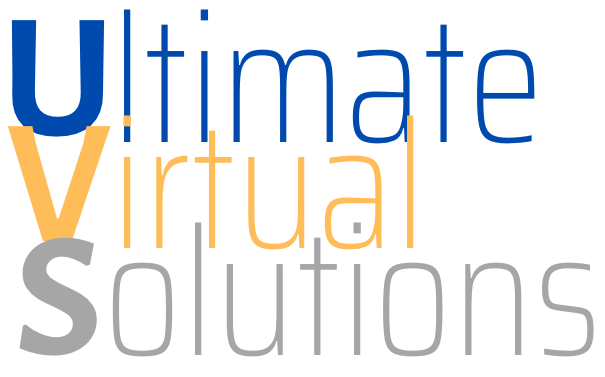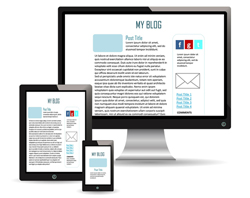 Are you thinking about getting a website or blog built for your business?
Are you thinking about getting a website or blog built for your business?
Then this guide to planning your website is for you.
Note: This is Part 3 of the article where we take you step-by-step through the process of planning your website or blog.
- For Part 1, go here: Planning Your Website - A Basic Guide - Part 1
- For Part 2 of the article series, go here: A Basic Guide To Website Planning - Part 2
A Basic Guide To Website Planning - Part 2
In Part 1 of this article, we have looked at the following areas of the website planning process:
- Step 1 - Define Your Site Goals
- Step 2 - Website Name
- Step 3 - Manage Your Site's Technology
- Step 4 - Define Your Audience
- Step 5 - Keywords
- Step 6 - Defining Your Site Categories
- Step 7 - Plan Your Content Strategy
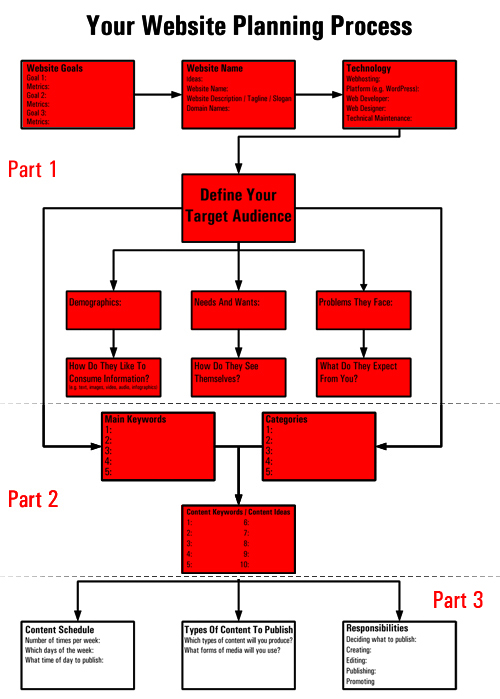
You're almost there with the initial website planning work. In this phase of the site planning process, we are going to set up an initial publishing schedule for your website, decide what type of content you are going to create for your website, and decide who is going to do what on your site.
Step 8 - Create Your Content Publishing Or Blogging Schedule
You need to be publishing content regularly for your business to grow online. A content publishing system is the most productive and effective way to plan, schedule and track your content creation and publishing process.
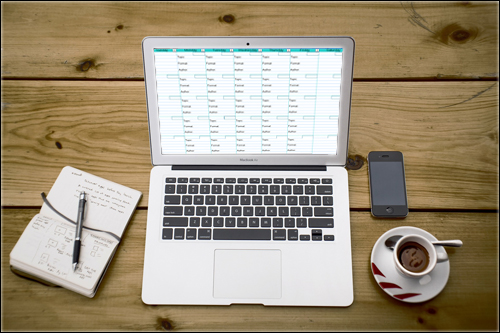
Creating Your Content Publishing Or Blogging Schedule
After creating an initial list of content ideas, the next step is to set up an initial blog or content publishing schedule.
![]()
Although this step may not seem to related directly with building your website, as you go through the process of creating a content publishing schedule and then thinking about what types of content you will need to create and who will be responsible for managing the content production and publishing areas (see Steps 9 and 10 below) will help you understand what kind of additional services or resources you will need immediately after your website has been created.
![]()
Practical Tips For New Website Owners:
Tip #1 - Publish Consistently
Publishing new content to your site consistently is extremely important for building an online audience and for helping your site's results in search engines.
This is the step where you are actively marketing and promoting your business online through content, and so it's crucial that you develop a habit of writing and publishing content about your business on a regular basis.
Start by making a commitment to publish a new post each week or fortnight to your website or blog. Decide on a specific weekday and the time of day that you will sit down to create your articles. Allow 1-2 hours to create and publish (or schedule for publishing) each content item.
Now, commit to turning this into a regular habit. Keep monitor this commitment and if required, adjust your schedule accordingly.
Remind yourself when you sit down to write your content that you are investing in your business.
Tip #2: Content Scheduling Tools
If you plan to publish content on your site on a regular basis (and you should!), it helps to keep your workflow organized.
You can use simple spreadsheets to help schedule and track your content content creation, or use a plugin.
Spreadsheet-Based Editorial Templates
You can keep things simple and schedule your content creation using any spreadsheet program ...
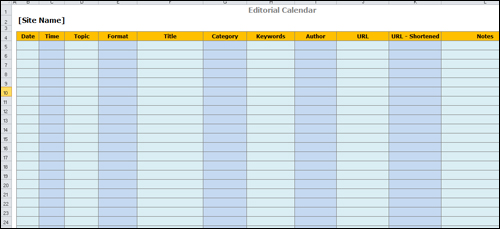
Editorial Template Created With Spreadsheet
Use this spreadsheet to plan your content creation and publishing schedule. For example, you can add the following columns to your spreadsheet:
- Publish Date: Record the date you plan to publish your content. Tip: You can use color-coding to indicate when content has been published. You can also add a second column to record 1) the date your content needs to be created by, and 2) the date your content is scheduled to publish on your site or blog.
- Writer: Who will write or create this content. (See Step 10 below)
- Format: Enter the type of content you will be creating for this item. (See Step 9 below)
- Category: If you are publishing to your blog, specify the category you will publish this item under.
- Offer: What is this particular item of content designed to sell or promote? Record your offer or call-to-action here.
- Headline: Enter your article or blog post headline, title of your content item, etc.
- Description: Enter a brief description or purpose of the content.
- SEO: The main keyword phrase targeted by your content.
- URL: After publishing the item, record its URL here. This will make it easier to find the content URL when promoting your content (e.g. on social media, emails, etc)
- Short URL: Add a shortened version of the content's destination URL for promoting on Twitter, or tracking your campaigns.
You don't need to have all of the above columns. You can keep things simple by creating a basic spreadsheet containing only these essential columns:
- Publish Date
- Content Writer
- Content Type
- Category.
If you would like to create an Editorial Calendar to help plan your content every month, you can search online for "free calendar" or download a free calendar template from WinCalendar.com ...
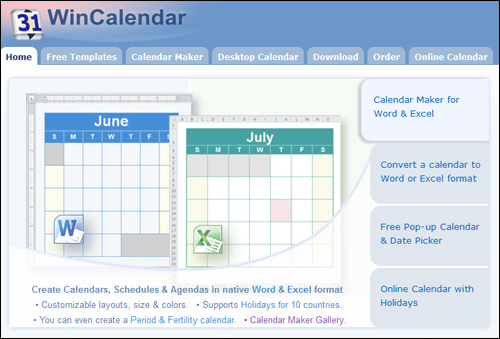
WinCalendar.com - Calendar Maker
WordPress Content Scheduling Plugins
If you want to manage your content scheduling directly from WordPress, there are some useful plugins for managing your content scheduling you can use:
Editorial Calendar - Editorial Plugin For WordPress
Editorial Calendar is a Free plugin for WordPress that makes it possible to see all your posts and drag and drop them to manage your site.
The Editorial Calendar provides content editors with an overview of your blog and when each item will be published. You can drag and drop to move posts, edit posts right inside the calendar and manage your entire content publishing schedule.
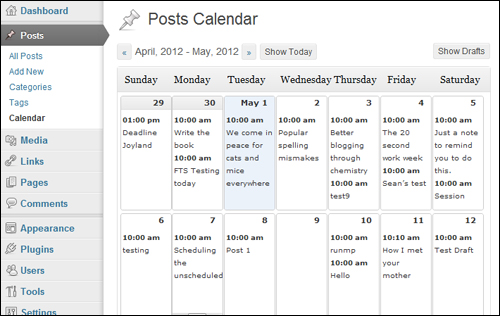
(Screenshot source: plugin site)
For more details about this useful content management plugin visit the plugin page here: Editorial Calendar
Edit Flow - Plugin For WordPress
Edit Flow is a modular plugin that empowers you to collaborate with your editorial team inside WordPress.
Key features of the plugin include:
- Calendar - A month-by-month view of your content.
- Custom Statuses - Define the key stages to your workflow.
- Editorial Comments - Allows private discussion between writers and editors in the admin via threaded commenting.
- Editorial Metadata - Helps you keep track of important details.
- Notifications - Lets you receive timely updates on any content that you are following.
- Story Budget - View your upcoming content budget.
- User Groups - Helps you organize your users by department or function.
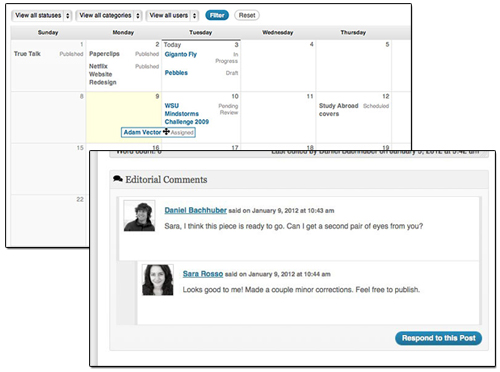
(Screenshot source: Edit Flow site)
For more details about this plugin visit this site: Edit Flow
Oasis Workflow - WordPress Plugin
Oasis Workflow is a powerful feature-rich plugin for WordPress that allows you to automate your WordPress editorial workflow using a simple, intuitive graphical user interface (GUI).
Some of the features of the Oasis Workflow plugin include the ability to configure your workflow using an easy drag and drop designer interface and simple process/task templates.
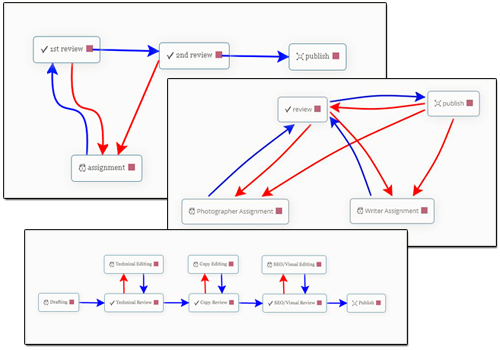
(Image source: plugin site)
This plugin also offers role-based routing definitions, lets users view their current assignments and sign off on their tasks once assignments are completed, process history for auditing purposes, task reassignment, due date and email reminders to help you to publish your articles on time, and an out of the box editable workflow to help you get started.
Oasis Workflow also has a "Pro" version that includes additional functionality, such as allowing you to set up multiple workflows, copy workflow and copy steps, auto submit, revise published content and much more.
For more details about this useful plugin visit this website: Oasis Workflow
Step 9 - Define What Type Of Content To Publish

What Type Of Content Will You Publish On Your Website Or Blog?
Once you have set up your schedule for creating content, the next step is to decide what types of content you are going to create to publish on your site.
Are you planning to publish articles, videos, audios, slideshows, product reviews, downloadable PDF reports, etc.?
Knowing what types of content you plan to create for your site is useful, because this helps you understand what other technologies and resources you may need to purchase or budget for in order to create the content. This could include buying video screen capture software for videos and multimedia presentations, slideshows, etc.
Step 10 - Assign Roles And Responsibilities

Who Is Going To Be Responsible For All Areas Of Your Site?
The last step in your business site planning process is to decide who will be responsible for managing the various aspects of your website and content and assign these to your in-house resources, or consider outsourcing.
There are many roles and responsibilities associated with running a growing web site or blog.
Ask yourself the following questions:
- Who will decide what content gets written/published on your site?
- Who will do the content creation work (e.g. content research, writing and reviewing, sourcing and outsourcing graphics and logos, videos, audios, newsletter content, training content, FAQs, etc.)?
- How will you communicate what needs doing to others? How will people communicate with each other to ensure that all the "fingers" talk to "the hand"?
- Who will manage the actual scheduling and publishing of content on your website or blog and update any outdated information?
- Who will promote and market the website with search engine optimization, online advertising, social media marketing, video marketing, etc.?
- Who will maintain and upgrade site software, install new applications, customize web templates, provide technical support, etc.?
- Who will be responsible for setting and monitoring the budget for all of the above areas (including budgeting for the cost of getting your site built)?
Who will be responsible for running all areas of your website or blog?
Depending on the size of your business, it may be just one person doing everything (e.g. you), or a few people, and perhaps even some outsourced help.
If you don't know the answer to the above questions before getting your website built, you could end up spending a lot of time and money building something that will not only not help you grow your business, but cost even more of your valuable money and time.
![]()
Tip: Focus On Processes, Not People When Assigning Responsibilities
Create a document (e.g. flowchart) outlining exactly who will do what in terms of managing your website and content creation.
Focus on documenting which roles should be responsible for the processes involved before assigning names to responsibilities or making people in your organization accountable for managing these. This will help you understand how much responsibility and work is involved in each part of the process, explain why you are asking people to take on additional responsibilities, and assist you in planning the allocation of resources accordingly.
Congratulations! You have completed all the sections of the site planning processand are now ready to start looking at options for getting your site built.
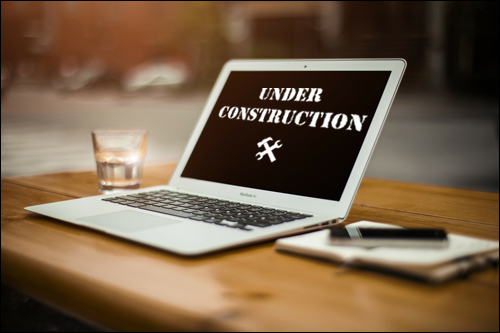
![]()
Hopefully this post has given you a better understanding of the website planning process and how WordPress can help you get better results online. If you need information or assistance with setting up your website or blog, see the other articles we've published on this site or contact us.
Discover more from Ultimate Virtual Solutions
Subscribe to get the latest posts sent to your email.
